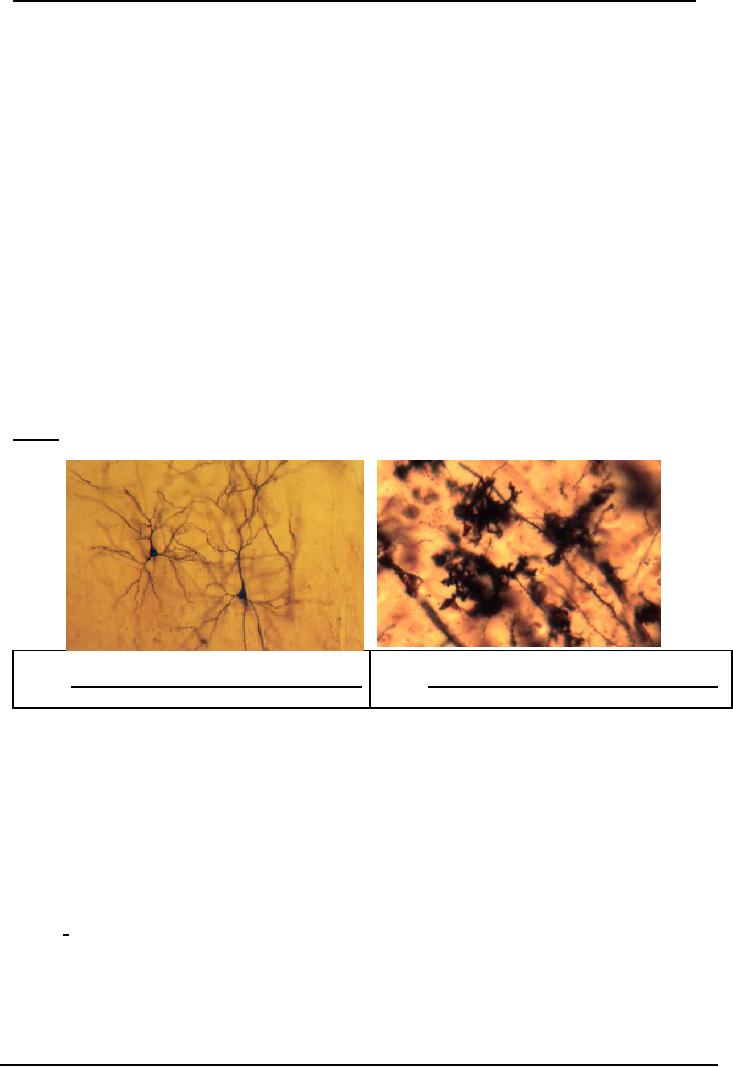 |
BRIEF HISTORICAL REVIEW:Roots of Behavioural Neurosciences |
| << INTRODUCTION:Descriptive, Experimental and/ or Natural Studies |
| SUB-SPECIALIZATIONS WITHIN THE BEHAVIORAL NEUROSCIENCES >> |

Neurological
Basis of Behavior (PSY -
610)
VU
LESSON
02
BRIEF
HISTORICAL REVIEW
Objectives:
�
To
orient students towards its
historical and scientific roots.
�
To
relate it to other areas of
specialization in Psychology.
Behavioural
Neurosciences is as wide as the fields
within the scope of its
domain and every
single
aspect
of brain/behavior relationship of any
organisms comes under its
purview. This has extended
more
recently
to a point where disciplines such as
neurophysics have emerged, and mathematical
modeling of
neural
connectivity and communication as
well as computer simulation of complex
experiences ( and
neural
networks) is very much part
of robotics.
Roots
of Behavioural Neurosciences
Basically
the roots of experimentation in psychology
emerge from adaptation of
methods of Physics.
The
well known psychophysical
methods were developed by Weber who
experimented on relationships
of
stimulus and responses. Relating
experiences to the brain has
its origins in the work of
William
James,
Karl Lashley, Sherrington
and Pavlov. To put forward
the view that biological
functions and
experiences
are related to the brain,
two names stand out,
that of Lashley and
Pavlov.
Experimentalists
believe that uncontrolled
observation is nonscientific; there are
too many uncontrolled
variables
in behaviors for us to draw
any conclusions.
Experimentalists
such as Pavlov believed in
controlling all possible conditions to
study behavior.
According
to this view, unless all
conditions are controlled,
studies of behavior would be
unscientific.
As
we all know, Pavlov the
Russian physiologist accidentally
discovered a different route to
studying
brain
behavior relationship. He was
also one of the first to connect
physiology with abnormal
behaviors
and
gave the concept of experimental
neurosis. This was a
condition of extreme emotional
reaction
which
he saw in his laboratory
dogs which were required to make
finer discriminations beyond
their
capacity.
Ethologists
and naturalists on the other
hand believe that when
behavior is controlled and
studied
under
laboratory conditions what we
see is not "real" behavior
but a construction in the
laboratory.
Ethology
studies behavior of organism as it occurs
in nature, under natural conditions.
Ethologists such
as
Konrad Lorenz (imprinting),
Niko Tinbergen (aggression, biological
basis), contributed
important
findings
regarding expression of behavior.
Imprinting has had a strong
impact on child and
developmental
studies. The belief that
controlling and restructuring behavior
led to unnatural
situation,
unnatural
response offered another methodology of
studying behavior as well as
theoretical inputs.
The
Yerkes
Primate Institute (Georgia: Chimp
language studies) and Wisconsin Primate Center (
Wisconsin:
Harlows'
Chimpanzee studies), Bar Harbor Maine
(Sociobiology) emerged out of
this tradition.
Neurophysiology
was
another input and came through the
work of Sir Charles Sherrington, and
Charles
Bell's
research on the reflex systems. An
excellent book on the nervous system
functioning and
integration
and the reflexes systems was
published as a consequence. Thus,
providing the beginnings of
the
study of nerve cells, their
development, and mechanism and
functioning.
Apart
form the input from the
major names, if we look
historically there are three major
inputs into this
discipline--from
Europe, Russia, and the
US.
6

Neurological
Basis of Behavior (PSY -
610)
VU
The
European
inputs are
from Germany (Weber, Fechner,
Helmholtz,), France (Broca),
Britain (Bell,
Sherrington),
Russia (Pavlov) and America
(William James, Lashley, and
Watson). There are
the
strands
which reflect the scientific
culture of the region as well as the
thinking and working of the
scientists
at the time.
Germany:
The
emergence of Psychophysics (S-R
relationships) from Weber's labs,
Fechner's work
relating
of experiences/ physiological responses to
physical stimuli are well
documented as the
beginning
of psychological experimentation.
Helmholtz,
another important contributor from
Germany, measured for the
first time the speed of
nerve
impulses.
His main contribution was in
the area of vision and analysis of the
visual apparatus and
processes.
His contribution of the study of
emotional/physiological states is also
well known and
studied
even
today. The two important
names of Fritz and Hitzig
emerge for relating the
brain to motor
control
of
functions.
Johannes
Muller's famous "Law of
Specific Energies of Nerves" (1838)
was given after an
experiment
demonstrated
that the stimulation resulted in a
response by the nerve.
France:
Flourens work on phrenology
(areas of brain and behavior) is
also well known. Marc
Dax is the
first
one to note that right
side paralysis affect speech as
well. Broca located the
motor control of
speech
known
as Broca's area. Later
Jouvet's contribution to sleep
research is also well
known.
Italy:
Camillio
Golgi is the first one to selectively
stain the cell bodies. This stain is now
known as
Golgi
Stain.
Source:www.neurostructural.org/images/eleven.jpg
Source:www.coloradocollege.edu/.../14.golgi2.JPG
Above
you can see the images of
Golgi stain .Towards the right is an
image of a Golgi Stain of
astrocytes
at higher magnification.
Spanish:
Ramon Cajal in 1889
anatomically studied synapses and
individual neurons. He also
studied
cells
and their interconnections.
Russian:
Pavlov's major contribution in
connecting physiology and
behavior. His work was
very much
focused
on experimental studies. Luria is
known as the father of Neuropsychology
and his studies were
on
gunshot wounds of WWI head injured
soldiers.
Britain:
Same time as Americans
studying brain substrates of
behavior, the Germans studying the
S-R
relationships,
the British studying the basic
properties of the brain, physiology,
anatomy and Chemistry.
Sherrington,
Father of Neurophysiology, prepared a report on the
nervous system as acting in an
integrated
coherent manner. The Reflex system
was clearly analyzed (reflex
arcs) and laid down
the
basis
of studying the neuron.
7

Neurological
Basis of Behavior (PSY -
610)
VU
South
America: The
first systematic attempts at human
psychosurgery occurred from 1935, when
the
neurosurgeon
Egas Moniz teamed up with
the surgeon Almeida Lima at the
University of Lisbon to
perform
a series of prefrontal lobotomies --a
procedure severing the connection between the
prefrontal
cortex
and the rest of the brain. Psychosurgery is a term
for surgeries of the brain
involving procedures
that
modulate the performance of the brain, and
thus effect changes in
cognition, with the intent to
treat
or
alleviate severe mental
illness. It was originally
thought that by severing the
nerves that give power
to
ideas
you would achieve the desirable result of
a loss of affect and an emotional
flattening which
would
diminish
creativity and imagination; the idea
being that those are the
human characteristics that
are
disturbed.
Historically, the procedure typically considered
psychosurgery, prefrontal leukotomy is
now
almost
universally shunned as inappropriate,
due in part to the emergence of
less-invasive or less-
objectionable
methods of treatment such as psychiatric
medication and modified
electroconvulsive
therapy.
In modern neurosurgery however, more minimally
invasive techniques like gamma
knife
irradiation
and foremost deep brain
stimulation have arisen as novel
tools for
psychosurgery.
American:
William
James made the first ever
laboratory in US. He studied the
role of brain as basic
to
all
behavior and experience. Karl Lashley
worked on learning and its
brain substrates. He also
worked
on
the distribution of information
circuitry. There are
integrated circuits which
connect the various
parts
of
the brain. His student was
Hebb, one of the foremost names in
neurosciences, whose
book,
"organization
of behavior" in 1949 actually
triggered the involvement of psychology
in brain science.
Some
of his studies on sleep and
motivation are also a
landmark. James Watson, a behaviorist,
stated
that
behavior can be measured
through cause-effect sequence
relationship. Bigelow (1850)
first reported
case
of Phineas Gage in relation to the change
in personality with brain
injury. Later many names in
the
US
such as Valenstein, Gazzaniga, Sperry,
Rakic, Merzenich etc. worked
on the brain behavior
relationship
Table
1: Important Contributors To
Neurosciences
Nobel
Prizewinner
Year
Contribution
Ivan
Pavlov
1904
Digestive
systems and their
physiology
Camillo
Golgi and Ramon 1906
Histological
identification of the structure of
Cajal
Neurons
and their connections
Charles
Sherrington
1932
Discoveries
of neuronal functioning and
reflex
and
Edgar Adrian
systems
Walter
Hess
1949
Control
of brain in behavioural expression
Egas
Moniz
1949
Development
of the prefrontal lobotomy
technique
John
Eccles Alan Hodgkin
1963
Ionic
basis of neuronal
conduction
and
Andrew Huxley
Bernard
Katz, Von Euler 1970
synaptic
transmission
and
Julius Axelrod
Karl
Von Frisch, Konrad 1973
Contribution
to studies of animal
behavior
Lorenz,
and Nikolass
Tinbergen
Roger
Sperry
1981
Brain
Hemispheric differences
David
Hubel and Torsten
1981
Information
processing
within
the brain
Weisel
structures
of visual system
Rita
Levi Montalcini and
1986
Discovery
of the Nerve growth
factor
Stanley
Cohen
Erwin
Neher and Bert 1991
Ionic
Channels
Sakman
Alfred
Gilman and Martin
1994
Discovery
of G-protein receptors
Rodbell
Arvid
Carlsson,
Paul
2000
Elaboration
of Synaptic transmission
Greengard,
and
Eric
Kandel
8

Neurological
Basis of Behavior (PSY -
610)
VU
Source:
From Pinel (2002) p
8.
Sub
Specializations
Areas
of sub- specializations within the
neurosciences;
1.
Biological
psychiatry: studies
biological basis of psychiatric disorders
and treatment utilizing
brain
manipulations.
2.
Biopsychology:
Focuses
on biological basis of behavior
i.e. how brain and other
biological
processes
affect psychological behaviors.
This has very strong
laboratory based
studies.
3.
Neurobiology
and Developmental neurobiology: Biological
systems (especially animals)
are
the
focus for this area. The
development and maturity of the nervous
systems and the processes
involved
are studied in
detail.
4.
Neuroanatomy:
This entails study of the
structures and systems of the brain
and how they
control
and
modulate behavior.
5.
Neurochemistry:
The
area investigates neurochemical modulations of
behavior, especially
synaptic
transmission (intra and inter
neuronal).
6.
Neuroethology:
Study of the brain and biological
basis of behavior as it occurs in the
natural
environment
basically how behavior
evolves changes (using an
evolutionary perspective).
7.
Neuroendocrinology:
studies hormonal influences
within the brain and modulation of
behavior
by
hormones.
8.
Neuropathology:
The
focus of this area is disorders of the
brain, how and why these
occur.
9.
Neuropharmacology:
studies the drug interactions
within the brain and their effects on
neuronal
transmission
and subsequently behavior.
10.
Neurophysiology: is the study
of the electrical signals/impulses; both
interneuronal and
intraneuronal
and related changes in
behavior.
11.
Neuropsychology: studies
brain and behavior correlates especially
for higher order
brain
functioning
and assessment rehabilitation of
patients.
Behavioral
Neurosciences aims to study and
understand the neurobiological,
neuroanatomical,
neurochemical
substrates of behavior. It aims to
understand the brain substrates,
modulators and
precipitators
of behaviors. This is wide
ranging and includes an understanding of
a large number of
related
disciplines, keeping in view the
complexity of the organ and behaviors
involved.
References:
�
Carlson
N.R. (2005). Foundations of
Physiological Psychology (5th Ed.) Allyn and Bacon,
Boston
�
Kalat J.W
(1998). Biological Psychology
(Ed.) Brooks/ Cole
Publishing
�
Pinel, John
P.J. (2003). Biopsychology
(5th Ed.) Allyn and Bacon;
Singapore
�
http://en.wikipedia.org/wiki/Psychosurgery
9
Table of Contents:
- INTRODUCTION:Descriptive, Experimental and/ or Natural Studies
- BRIEF HISTORICAL REVIEW:Roots of Behavioural Neurosciences
- SUB-SPECIALIZATIONS WITHIN THE BEHAVIORAL NEUROSCIENCES
- RESEARCH IN BEHAVIOURAL NEUROSCIENCES:Animal Subjects, Experimental Method
- EVOLUTIONARY AND GENETIC BASIS OF BEHAVIOUR:Species specific
- EVOLUTIONARY AND GENETIC BASIS OF BEHAVIOUR:Decent With Modification
- EVOLUTIONARY AND GENETIC BASIS OF BEHAVIOUR:Stereoscopic vision
- GENES AND EXPERIENCE:Fixed Pattern, Proteins, Genotype, Phenotypic
- GENES AND EXPERIENCE:Mendelian Genetics, DNA, Sex Influenced Traits
- GENES AND EXPERIENCE:Genetic Basis of behavior, In breeding
- GENES AND EXPERIENCE:Hybrid vigor, Chromosomal Abnormalities
- GENES AND EXPERIENCE:Behavioral Characteristics, Alcoholism
- RESEARCH METHODS AND TECHNIQUES OF ASSESSMENT OF BRAIN FUNCTION
- RESEARCH METHODS AND TECHNIQUES OF ASSESSMENT OF BRAIN FUNCTION:Activating brain
- RESEARCH METHODS AND TECHNIQUES OF ASSESSMENT OF BRAIN FUNCTION:Macro electrodes
- RESEARCH METHODS AND TECHNIQUES OF ASSESSMENT OF BRAIN FUNCTION:Water Mazes.
- DEVELOPMENT OF THE NERVOUS SYSTEM:Operation Head Start
- DEVELOPMENT OF THE NERVOUS SYSTEM:Teratology studies, Aristotle
- DEVELOPMENT OF THE NERVOUS SYSTEM:Stages of development, Neurulation
- DEVELOPMENT OF THE NERVOUS SYSTEM:Cell competition, Synaptic Rearrangement
- DEVELOPMENT OF THE NERVOUS SYSTEM:The issues still remain
- DEVELOPMENT OF THE NERVOUS SYSTEM:Post natal
- DEVELOPMENT OF THE NERVOUS SYSTEM:Oxygen level
- Basic Neuroanatomy:Brain and spinal cord, Glial cells, Oligodendrocytes
- Basic Neuroanatomy:Neuron Structure, Cell Soma, Cytoplasm, Nucleolus
- Basic Neuroanatomy:Control of molecules, Electrical charges, Proximal-distal
- Basic Neuroanatomy:Telencephalon, Mesencephalon. Myelencephalon
- Basic Neuroanatomy:Tegmentum, Substantia Nigra, MID BRAIN areas
- Basic Neuroanatomy:Diencephalon, Hypothalmus, Telencephalon, Frontal Lobe
- Basic Neurochemistry:Neurochemicals, Neuromodulator, Synaptic cleft
- Basic Neurochemistry:Changes in ionic gates, The direct method, Methods of Locating NT
- Basic Neurochemistry:Major Neurotransmitters, Mesolimbic, Metabolic degradation
- Basic Neurochemistry:Norepinephrine/ Noradrenaline, NA synthesis, Noadrenergic Pathways
- Basic Neurochemistry:NA and Feeding, NE and self stimulation: ICS
- Basic Neurochemistry:5HT and Behaviors, Serotonin and sleep, Other behaviours
- Basic Neurochemistry:ACH and Behaviors, Arousal, Drinking, Sham rage and attack
- Brain and Motivational States:Homeostasis, Temperature Regulation, Ectotherms
- Brain and Motivational States:Biological Rhythms, Circadian rhythms, Hunger/Feeding
- Brain and Motivational States:Gastric factors, Lipostatic theory, Neural Control of feeding
- Brain and Motivational States:Resting metabolic state, Individual differences
- Brain and Motivational States:Sleep and Dreams, Characteristics of sleep
- Higher Order Brain functions:Brain correlates, Language, Speech Comprehension
- Higher Order Brain functions:Aphasia and Dyslexia, Aphasias related to speech
- Higher Order Brain Functions:Principle of Mass Action, Long-term memory
- Higher Order Brain Functions:Brain correlates, Handedness, Frontal lobe